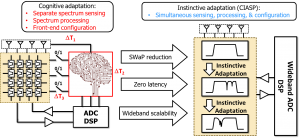
The ever increasing quest for wireless capacity and the resulting spectrum congestion calls for substantial changes in spectral processors as we know today. Current spectral processors used in RF front-end modules are linear time-invariant systems, incapable of intelligent adaptation to the constantly changing spectrum availabilities. The required intelligence can be added by using complex system designs, exploiting numerous modules for spectrum sensing and processor configuration. However, putting the entire load on system-level solutions impose huge power consumption and may not be scalable as the number and frequency of communication bands grows into mm-wave.
To address these issues, we are developing a new generation of “intelligent” spectral processors that provide instinctive adaptation according to the input signal amplitude or direction of signal insertion. These processors relies on different nonlinear operation physics ranging from acoustoelectric anharmonic coupling in semiconductors, to ferroelastic and electrostrictive electromechanical coupling in ferroic transducers.
Two specific systems that we are currently developing are: (1) nonreciprocal RF filters based on deformation potential coupling in single-crystal germanium, and (2) instinctually adaptive jamme-immune filters based on super-harmonic coupling in ferroic hafnia-zirconia. These projects are supported through NSF and DARPA grants.
Featured Publications:
- Hakim, S. Rassay, M. Ramezani, and R. Tabrizian, “A Non-Reciprocal Lamb-Wave Delay Line Exploiting Acoustoelectric Effect in Single Crystal Germanium,” Proc. IEEE International Conference on Micro Electro Mechanical Systems (MEMS ‘20), pp. 1246 – 1249, January 2020.
- M. Ghatge, G. Walters, T. Nishida, and R. Tabrizian, “A Non-Reciprocal Filter using Asymmetrically Transduced Micro-Acoustic Resonators,” IEEE Electron Device Letters, March 2019, 40(5), 800-803.